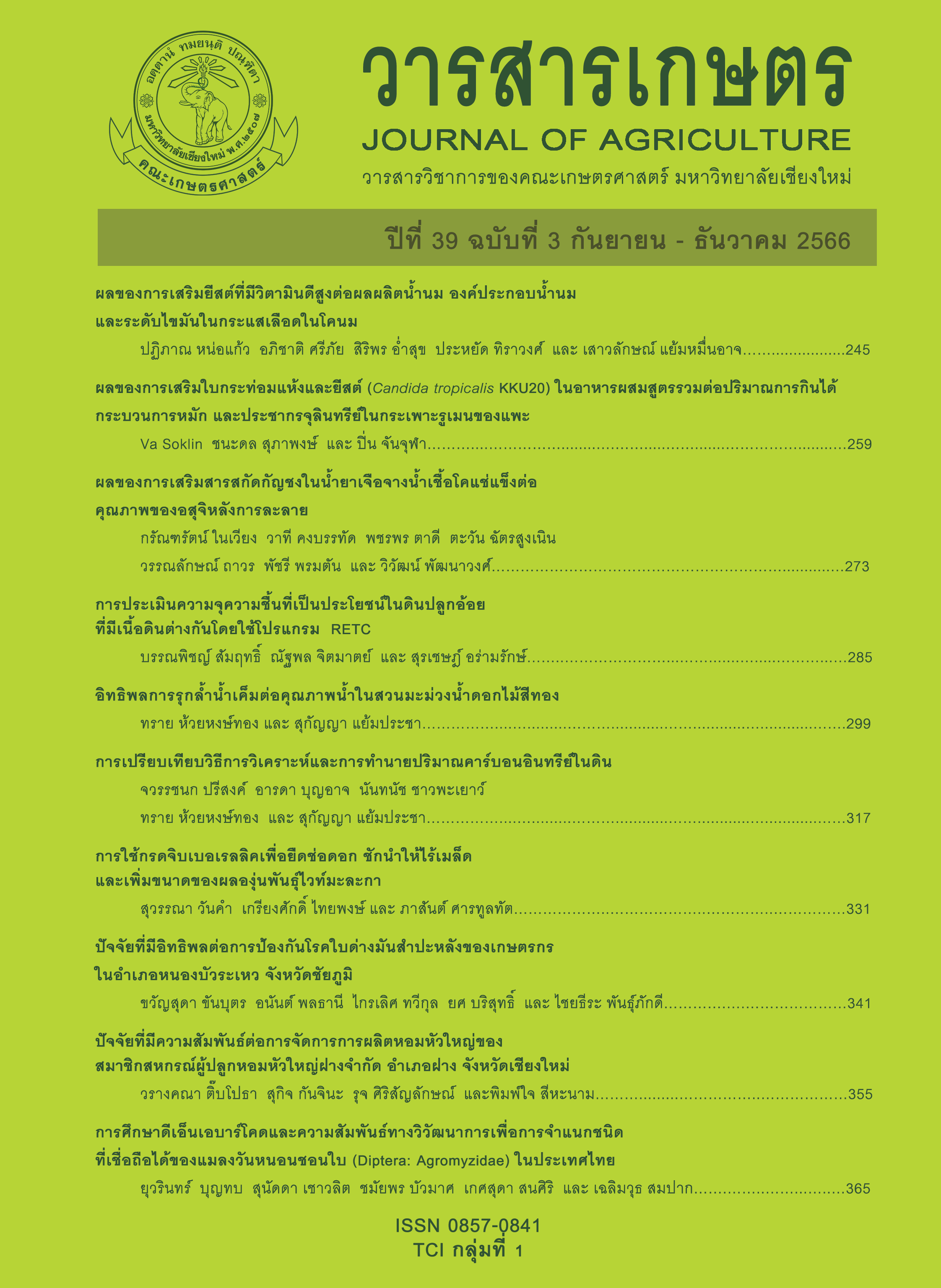Evaluation of Available Soil Water Capacity in Different Textured Sugarcane Growing Soils Using RETC Program
Main Article Content
Abstract
The assessment of available soil water capacity (θAWC) of tropical soils is often inconsistent with the appropriate determination of the field capacity (θFC) in different soil textures, which affects identifying critical water content and irrigation. This study aimed to compare the assessment method of θFC by hydraulic parameters from soil water retention curve (SWRC) to θFC at pF 2.0, a standard method used for laboratory pressure apparatus for evaluation of θAWC of different textural sugarcane growing soils in grouping to coarse, medium, fine, and gravelly textures, 3 locations of each textural type were collected at the depths of 0-Ap, Ap-60, and 60 - 100 centimeters. Particle size distribution, bulk density (ρb), and soil water content (θv) at pF levels 0, 1.0, 1.5, 2.0, 2.5, 3.0, and 4.2 were analyzed, then the θFC was estimated at maximum hydraulic capacity (Cw(h)) from SWRC obtained from experiment data with van Genuchten’s model in RETC program. The results found that the predicted (θFC at Cw(h)) value was below pF 2.0, which was in the pF of 0.85 - 1.78. Therefore, this suggested that the assessments to θFC at Cw(h) depend on textural types and can be applied in the laboratory to determine more accurate critical soil water content, intervals, and amount of irrigation for sugarcane.
Article Details

This work is licensed under a Creative Commons Attribution-NonCommercial-NoDerivatives 4.0 International License.
References
Alaboz, P., S. Demir, O. Dengiz and İ. Öz. 2021. Effect of biogas waste applications on soil moisture characteristic curve and assessment of the predictive accuracy of the van Genuchten model. Eurasian Journal of Soil Science 10(2): 142-149.
Allen, R.G., L.S. Pereira, D. Raes and M. Smith. 1998. Crop Evapotranspiration: Guidelines for Computing Crop water Requirements. FAO Irrigation and Drainage Paper No. 56. FAO, Rome. 300 p.
Blake, G.R. and K.H. Hartge. 1986. Bulk density. pp 363-375. In: A. Klute (ed.). Methods of Soil Analysis. Part 1: Physical and Mineralogical Methods. 2nd ed. American Society of Agronomy, Inc., Madison, Wisconsin.
Brooks, R.H., and A.T. Corey. 1964. “Hydraulic properties of porous media”. Hydrology Paper No. 3, Colorado State University, Fort Collins, Colorado. 37 p
Day, P.R. 1965. Particle fractionation and particle‐size analysis. pp.545-567. In: C.A. Black, D.D. Evaris, L.E. Ensminger, J.L. White and F.E. Clark (eds.). Methods of Soil Analysis: Part 1: Physical and Mineralogical Properties, Including Statistics of Measurement and Sampling. American Society of Agronomy. Inc, Madison, Wisconsin.
Durner, W. 1994. Hydraulic conductivity estimation for soils with heterogeneous pore structure. Water Resources Research 30(2): 211-223.
Gardner, W.H. 1965. Water content. pp. 82-127. In: C.A. Black, D.D. Evaris, L.E. Ensminger, J.L. White and F.E. Clark (eds.). Methods of Soil Analysis: Part 1: Physical and Mineralogical Properties, Including Statistics of Measurement and Sampling. American Society of Agronomy. Inc, Madison, Wisconsin.
Kosugi, K.1996. Lognormal distribution model for unsaturated soil hydraulic properties. Water Resources Research 32(9): 2697-2703.
Montanarella, L., F. Kaser and B. Hansen. 1998. European soil databases as a tool for EU risk assessment and decision making. TrAC Trends in Analytical Chemistry 17(5): 257-263.
Mualem, Y. 1976. A Catalogue of the Hydraulic Properties of Unsaturated Soils. Technion Israel Institute of Technology, Technion Research and Development Foundation, Haifa. 100 p.
National Soil Survey Center. 1996. Soil Survey Laboratory Methods Manual. National Soil Survey Center, Lincoln, Nebraska. 693 p.
Nemes, A. and W.J. Rawls. 2004. Soil texture and particle-size distribution as input to estimate soil hydraulic properties. Developments in Soil Science 30: 47-70.
Paisancharoen, K., T. Sansayawichai, S. Luanmanee, S. Thippayarugs, K. Chusorn, J. Chuenrung and C. Pakdeethai. 2012. Water requirement and Kc values of Khon Kaen 3 sugarcane variety. Khon Kaen Agriculture Journal 40(Suppl. 3): 103-114. (in Thai)
Panawong, T. 2021. Physical quality and fertility of lateritic soils as influenced by dry dipterocarp forest and crop cultivation. M.S. Thesis. Kasetsart University, Bangkok. 86 p.(in Thai)
Radcliffe, D.E. and J. Simunek. 2010. Soil Physics with Hydrus: Modeling and Applications. CRC Press, Boca Ration.
Tawornpruek, S., P. Pinjai, N. Chittamart, T. Darunsonthaya, R. Charoensri, R. Lertphayakkharatsri, S. Wattana, K. Homyamyen, D. Waicharean and B. Rosopha. 2015. Development of soil quality and productivity index for sugarcane production in the eastern region of Thailand. Research report. Thailand Science Research and Innovation, Bangkok. 96 p. (in Thai)
van Genuchten, M.T. 1980. A closed‐form equation for predicting the hydraulic conductivity of unsaturated soils. Soil Science Society of America Journal 44(5): 892-898.
van Genuchten, M.T., F.J. Leij and S.R. Yates. 1991. The RETC code for quantifying the hydraulic functions of unsaturated soils. Oklahoma: EPA/600/2-91/065. U.S Environmental Protection Agency, ADA, Oklahoma. 85 p.
Yingjajaval, S. and K. Sangkhasila. 1991. The upper limit of available water for Kamphaeng Saen soil series. Agriculture and Natural Resources 25: 177-190. (in Thai)

